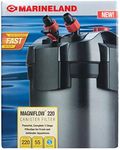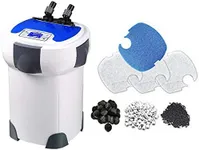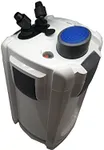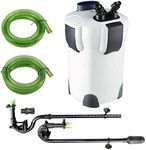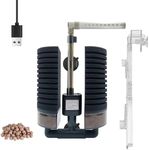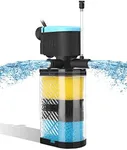Buying Guide for the Best External Aquarium Filters
Choosing the right external aquarium filter is crucial for maintaining a healthy and clean environment for your aquatic pets. An external filter, also known as a canister filter, is placed outside the aquarium and uses a pump to draw water out of the tank, filter it, and then return the clean water back into the tank. This type of filter is generally more powerful and efficient than internal filters, making it suitable for larger tanks or tanks with a high bioload. When selecting an external aquarium filter, consider the following key specifications to ensure you pick the best fit for your needs.Flow RateFlow rate refers to the amount of water the filter can process in an hour, usually measured in gallons per hour (GPH) or liters per hour (LPH). This spec is important because it determines how effectively the filter can clean the water in your tank. For a healthy aquarium, the filter should ideally process all the water in the tank at least four times per hour. For example, if you have a 50-gallon tank, you should look for a filter with a flow rate of at least 200 GPH. If you have a heavily stocked tank or one with messy fish, you might need a higher flow rate to maintain water quality.
Filter Media CapacityFilter media capacity refers to the amount and type of media the filter can hold. Filter media are the materials used to remove impurities from the water, including mechanical, chemical, and biological media. This spec is important because a larger capacity allows for more effective filtration and longer intervals between maintenance. If you have a large tank or a tank with a high bioload, you will benefit from a filter with a higher media capacity. Consider your tank's specific needs, such as the type of fish and plants you have, to determine the right media capacity for you.
Noise LevelNoise level refers to how much sound the filter produces while operating. This spec is important if your aquarium is located in a living space where noise could be a disturbance. Filters with lower noise levels are generally more desirable for home aquariums. Noise levels can vary significantly between models, so if a quiet environment is important to you, look for filters that are specifically designed to operate quietly. Reading user reviews and manufacturer specifications can help you gauge the noise level of a filter.
Ease of MaintenanceEase of maintenance refers to how simple it is to clean and maintain the filter. This spec is important because regular maintenance is necessary to keep the filter functioning properly and to ensure the health of your aquarium. Filters that are easy to disassemble and reassemble, with accessible media compartments, will save you time and effort. If you are new to aquarium keeping or prefer a low-maintenance setup, look for filters that are known for their user-friendly design and straightforward maintenance procedures.
Energy EfficiencyEnergy efficiency refers to how much power the filter consumes while operating. This spec is important because a more energy-efficient filter will cost less to run over time and is better for the environment. Filters with lower wattage ratings are generally more energy-efficient. If you are concerned about energy consumption or want to reduce your electricity bills, look for filters that are designed to be energy-efficient. Checking the wattage and comparing it to the flow rate can give you an idea of the filter's efficiency.
Durability and Build QualityDurability and build quality refer to how well the filter is constructed and how long it is likely to last. This spec is important because a well-built filter will provide reliable performance and require fewer replacements or repairs. Filters made from high-quality materials and with robust construction are generally more durable. If you want a filter that will last for many years, look for models with good reviews regarding their build quality and durability. Considering the reputation of the manufacturer can also be a good indicator of the filter's longevity.


